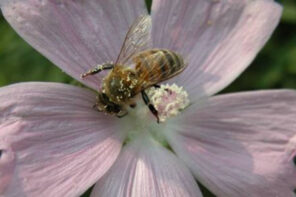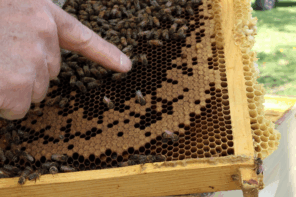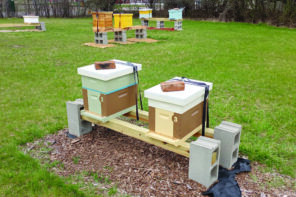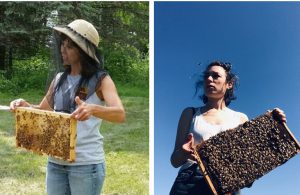
Becky Masterman led the UMN Bee Squad from
2013-2019. Bridget Mendel joined the Bee Squad in 2013 and has led the program since 2020. Photos of Becky (left) and Bridget (right) looking for their
respective hives. If you would like to contact the authors with your own robbing stories other thoughts, please send an email to
mindingyourbeesandcues@gmail.com
Robbing the Honey Bank
Becky Masterman & Bridget Mendel
Honey bee management inspection protocols change throughout the season and beekeepers need to look to the flowers for guidance. When nectar availability is limited, honey bee robbing (worker bees from other colonies stealing nectar and honey) should be a concern. Honey robbing is a complex foraging strategy that is associated with increased defensiveness and aggression in both the robbers and colonies being robbed (Grume et al. 2021) If threatened by robbing, your colonies will be forced to move workers from foraging to colony protection. Robbing can strip a colony of resources in the blink of a compound eye, and the colony could end up perishing.
Sometimes, it’s hard to recognize robbing. It can start out innocently as bees landing on a frame that you have removed to inspect a colony (Figure 1). A bee sipping nectar from this frame can return to her hive and report the location of the easily accessed, sweet carbohydrate and recruit her sisters to the open hive. When floral resources are plentiful, this happens infrequently. In a nectar dearth, this difficult to notice frame visit can lead to chaos in your apiary (Figure 2).
Beekeepers with less experience often recognize the signs of robbing only when their colony is under full attack. At this point, there are some obvious signs that are easy to identify. First, you will see bees fighting each other at the hive entrance. Guard bees will engage robbers and try to remove them or keep them out of the hive. The other identifier is the way that robbers attempt to enter the hive wherever the boxes meet, not just at the hive entrance (Figure 2).
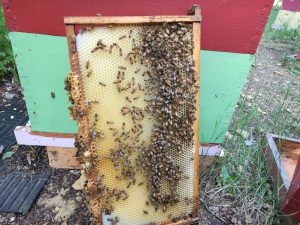
Figure 1. Setting a frame
outside of a hive to make colony inspection is a safe management technique
when nectar is flowing. In a nectar dearth, opportunistic robber bees might land on the frame and not be noticed by the beekeeper.
Photo Credit:
Rebecca Masterman
Other robbing signs that a beekeeper can learn to identify is how the bees look and fly. Over time, an experienced robber will have engaged in fighting and lost hair. These bees appear shiny and the black cuticle of their thoraces are easily visible when hairless. Bees robbing a hive also have a characteristic flight pattern. In a series of elegant behavioral experiments, Free (1954) investigated the swaying flight behavior of bees robbing hives. He trained bees to forage in a hive without bees and then moved a populated hive to the same site, creating a robbing event when the trained foragers returned. As a result of congestion at the hive entrance, the trained foragers turned robbers would sway in flight as they approached the entrance. The author hypothesized that the swayers were waiting for an opportunity to enter the hive without being stopped by guard bees. The swaying flight behavior was also noted to be a cue to guard bees of a possible threat. Evidence suggested that swaying flight was caused by entrance congestion; it also happens at hives that are not under attack but are experiencing heavy flight activity due to foraging or orientation flights.
You can take steps to limit robbing in your apiary. During times of nectar dearth, reducing hive entrances so hives are easier to defend can help your bees stop the threat of robbers (Free, 1954). Robbing screens are also effective ways to deter robbing bees. Most importantly, when you manage your bees during nectar dearth periods, do not leave hives open or frames out if possible. Extra bee equipment can go a long way in preventing robbing. If you cover open boxes that are not being inspected and place frames in empty boxes if you need to remove them for easier inspection of the colony, you can limit the exposure of your colonies.
Some days the Bee Squad apiary at the University of Minnesota looks like laundry day at a boarding house. There are times when data need to be collected and all colonies need to be opened. Robbing is inevitable, and measures will need to be taken to stop it. In addition to reducing hive entrances (NEVER completely close them!) we use wet sheets to cover the hives and protect them from robbers. It means that returning foragers end up sitting on the wet sheets and flight departures are delayed until the crisis is averted, but it also provides a measure of protection from the robber bees.
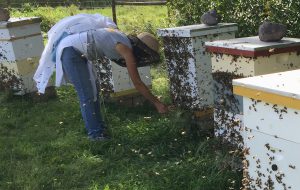
Figure 2. Chaos in the apiary when robbing is
rampant. Note the bees on the box seams, the beekeper reducing the entrances and a pile of sheets about to be placed on the hives to reduce robbing.
Photo Credit: Judy Griesedieck
Unfortunately, you can’t stop your bees from robbing other colonies. Before you start getting excited about any extra honey for your apiary, consider the risk when your bees enter other hives. Lindström et al. (2008) demonstrated that American Foulbrood (AFB) or Paenibacillus larvae spores can be moved by robber bees from diseased or dead AFB colonies to their own. This transmission caused infection in colonies within one kilometer of the AFB colonies. Although the risk of robbing and AFB transmission was described by earlier researchers, this study demonstrated that the highest risk was infected colonies within the one kilometer range.
Too many bee management topics lead to varroa and the viruses they vector. Researchers have suspected that colonies collapsing from varroa and vectored viruses have been a source of pest infestation and research has explored the role of robber honey bees in transmitting varroa mites (and the viruses their vector) back to colonies (Frey and Rosenkranz (2014), Peck and Seeley (2019) and Kulhanek et al. (2021). Readers, stay tuned as this research suggests that the process is complex and deserves more exploration. Regardless, Kulhanek et al. (2021) recommends that robbing screens could help to mitigate this issue.
Knowing the signs of honey bee robbing behavior along with smart management protocols when robbing risks are highest can keep your management season a little less eventful. Combined with strong, healthy colonies and a dedicated varroa monitoring schedule to pick up population spikes that your bees might have manifested, you can keep the drama out of your apiary and the honey in your hives.
References
Grume, GJ, Biedenbender, SP, Rittschof, CC (2021) Honey robbing causes coordinated changes in foraging and nest defence in the honey bee, Apis mellifera, Animal Behaviour, Volume 173, Pages 53-65, ISSN 0003-3472, https://doi.org/10.1016/j.anbehav.2020.12.019.
Free, JB (1954) The behaviour of robber honeybees. Behaviour, 7, pp. 233-240
Lindström, A, Korpela, S, and Fries, I. (2008) Horizontal transmission of Paenibacillus larvae spores between honey bee (Apis mellifera) colonies through robbing. Apidologie 39, 515–522. https://doi.org/10.1051/apido:2008032
Frey E, Rosenkranz P. Autumn invasion rates of Varroa destructor (Mesostigmata: Varroidae) into honey bee (Hymenoptera: Apidae) colonies and the resulting increase in mite populations. J Econ Entomol. 2014 Apr;107(2):508-15. doi: 10.1603/ec13381. PMID: 24772528.
Peck DT, Seeley TD. (2019) Mite bombs or robber lures? The roles of drifting and robbing in Varroa destructor transmission from collapsing honey bee colonies to their neighbors. PLoS One. 2019 Jun 21;14(6):e0218392. doi: 10.1371/journal.pone.0218392. PMID: 31226130; PMCID: PMC6588223.
Kulhanek, K, Garavito, A and vanEngelsdorp, D. (2021) Accelerated Varroa destructor population growth in honey bee (Apis mellifera) colonies is associated with visitation from non-natal bees. Sci Rep 11, 7092 (2021). https://doi.org/10.1038/s41598-021-86558-8
Acknowledgement The authors would like to thank Dr. Marla Spivak for helpful edits and suggestions.






